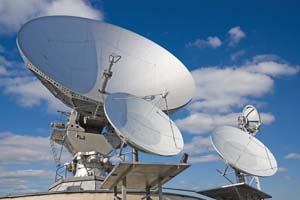Eutelsat Communications and Qatari partner Es’hailSat have announced that their jointly-owned Eutelsat 25B/Es’hail 1 satellite has been successfully launched by an Ariane 5 rocket and is on course for geostationary orbit. Es’hail 1 will broadcast more than 30 high definition television (HDTV) and 70 standard definition television (SDTV) channels, it was announced by Qatar Satellite […]
 Eutelsat Communications and Qatari partner Es’hailSat have announced that their jointly-owned Eutelsat 25B/Es’hail 1 satellite has been successfully launched by an Ariane 5 rocket and is on course for geostationary orbit.
Eutelsat Communications and Qatari partner Es’hailSat have announced that their jointly-owned Eutelsat 25B/Es’hail 1 satellite has been successfully launched by an Ariane 5 rocket and is on course for geostationary orbit.
Es’hail 1 will broadcast more than 30 high definition television (HDTV) and 70 standard definition television (SDTV) channels, it was announced by Qatar Satellite Co (Es’hailSat). Qatar TV, Al Jazeera channel, Al Rayyan TV and Al Kass sports channel, are some of the channels that will be broadcast from the satellite. Services of the new satellite are expected to be available by December.
The companies aim to bring the satellite into service at 25.5° East at the end of October.
Ali Ahmed Al-Kuwari, CEO of EshailSat, said: We are immensely proud to have witnessed here in Kourou the birth of a new star over Qatar with the successful launch of our Eshail 1 satellite. The EshailSat programme plays an important strategic role as Qatar works to meet the rapidly growing communications needs in the region. With the arrival of Eshail 1, we have completed the first step in our mission to become a centre of excellence in the region and develop a sustainable national satellite industry. Qatars first satellite will provide our strategic stakeholders and commercial customers with broadcasting independence, quality service and wide geographical coverage. We congratulate Arianespace on delivering a picture-perfect lift-off and look forward to working with Eutelsats operations team to bring Eshail 1 into service.
Based on the SSL 1300 platform of Space Systems/Loral, the Eutelsat 25B/Es’hail 1 is designed to serve broadcasters, businesses and public agencies in the Middle East, North Africa and Central Asia via capacity in the Ku and Ka-bands.
It will replace the Eutelsat 25C satellite at the key 25.5° East position.
Eutelsat 25C will be deployed to another location where it will provide commercial service.
















































































